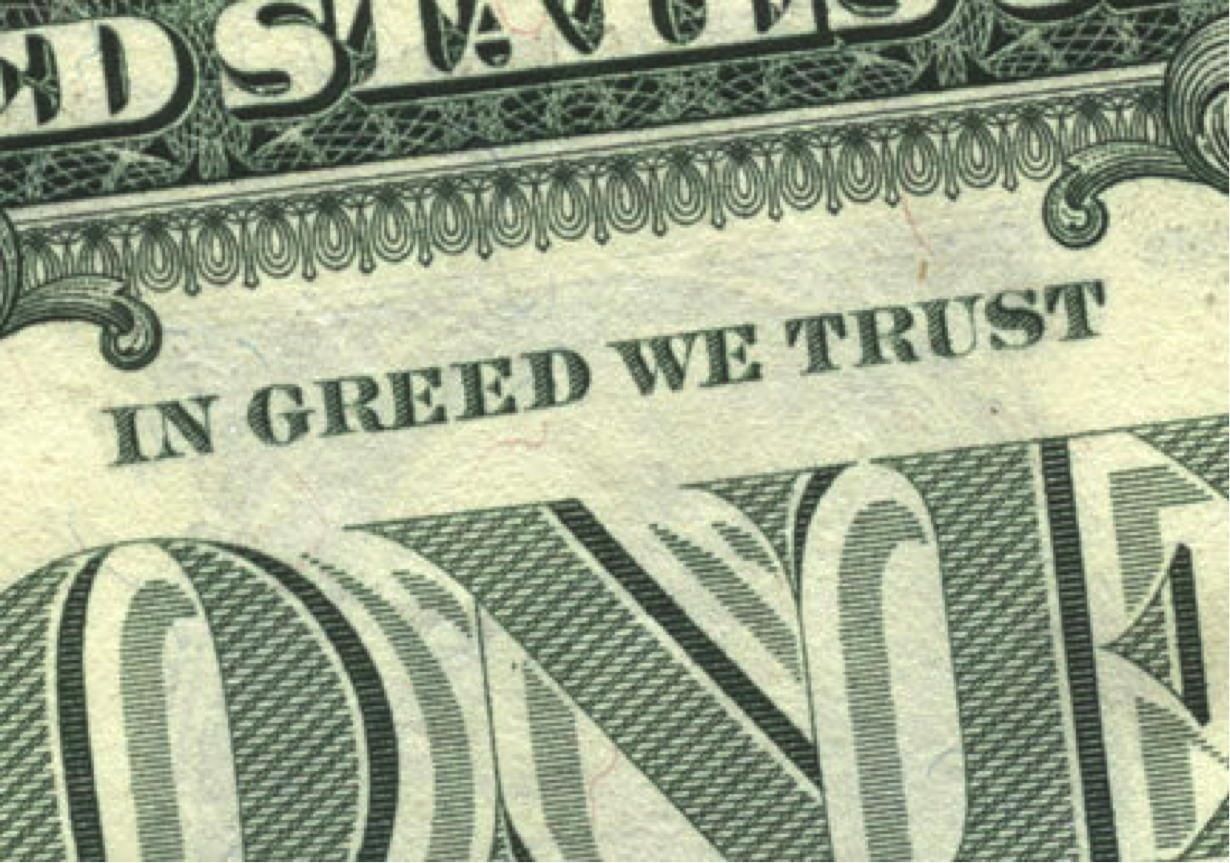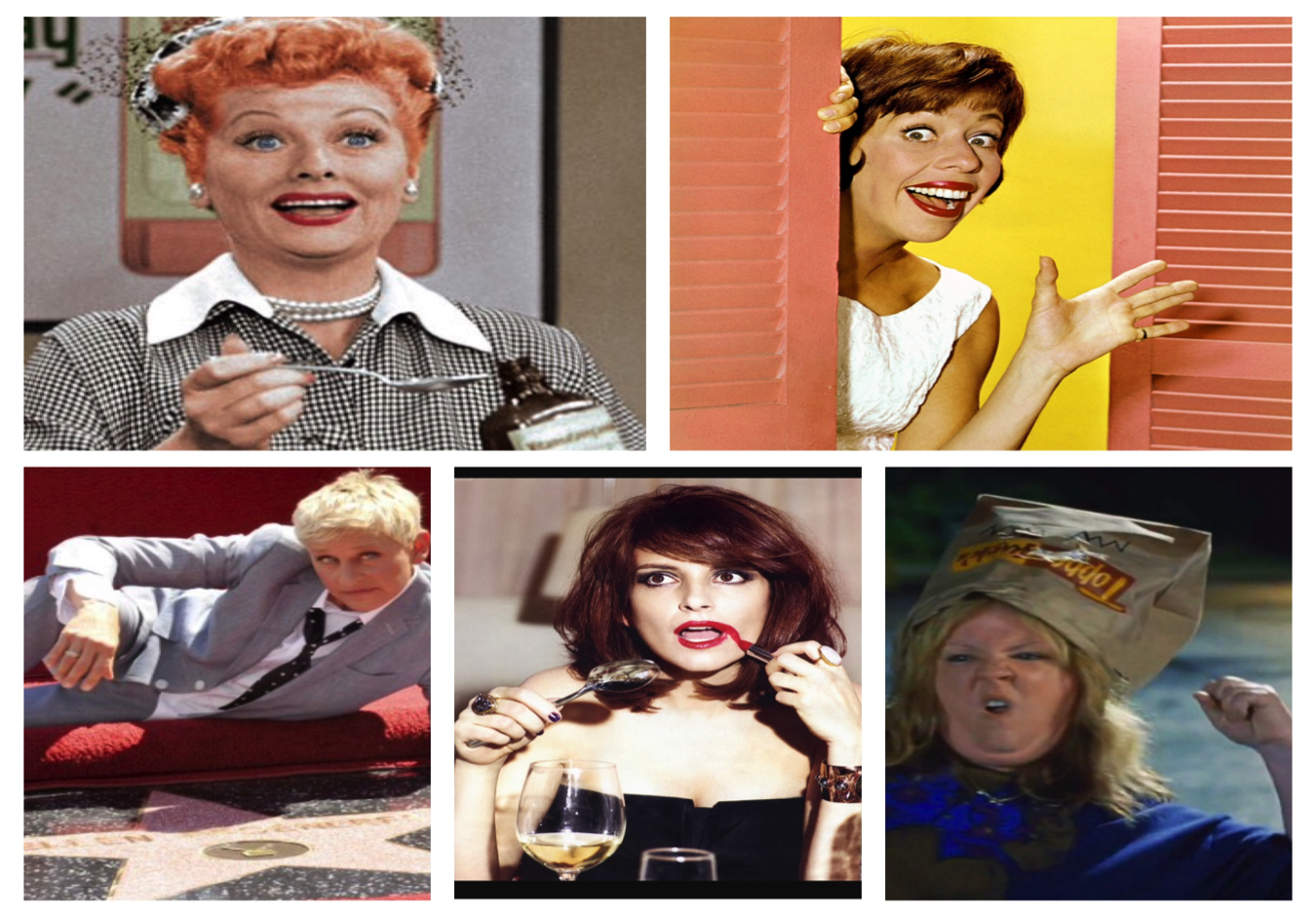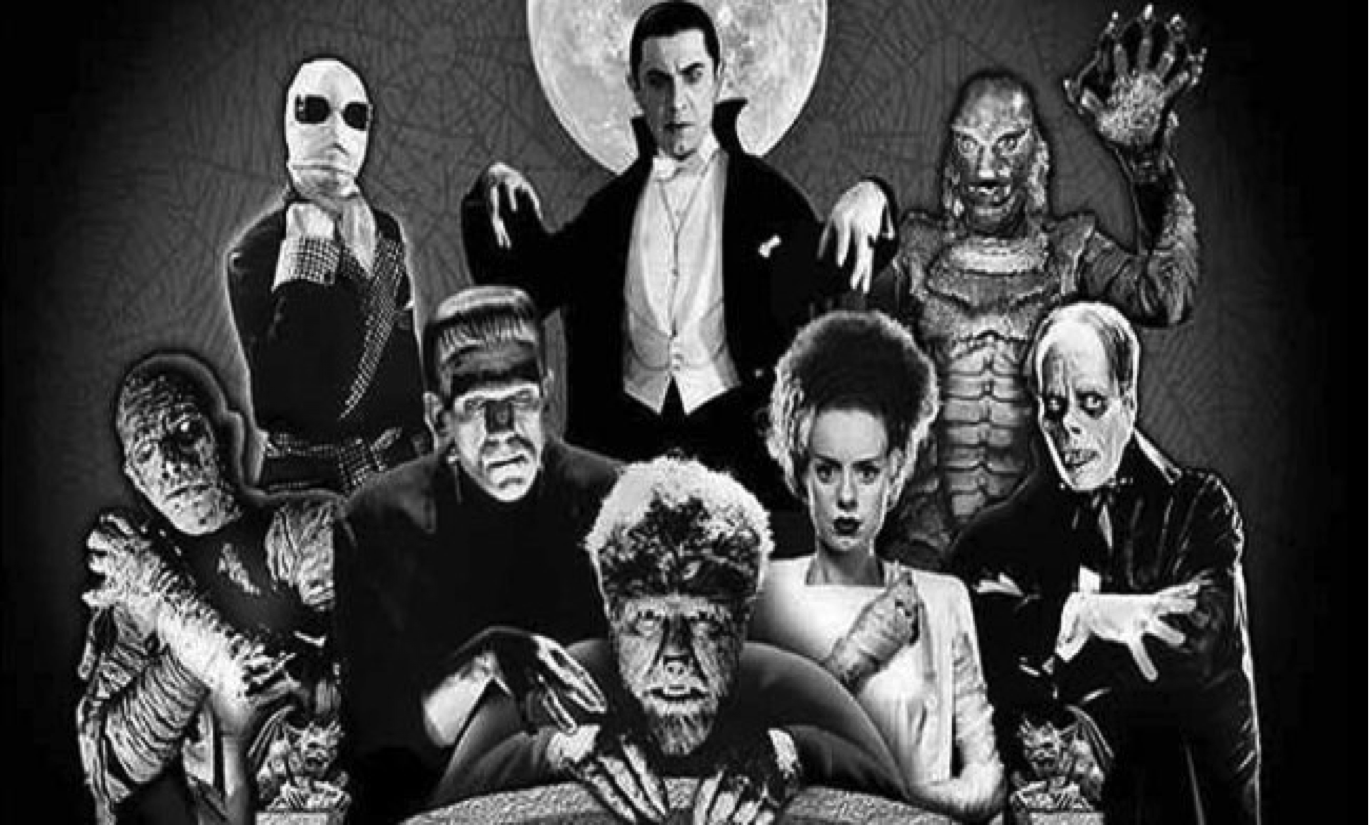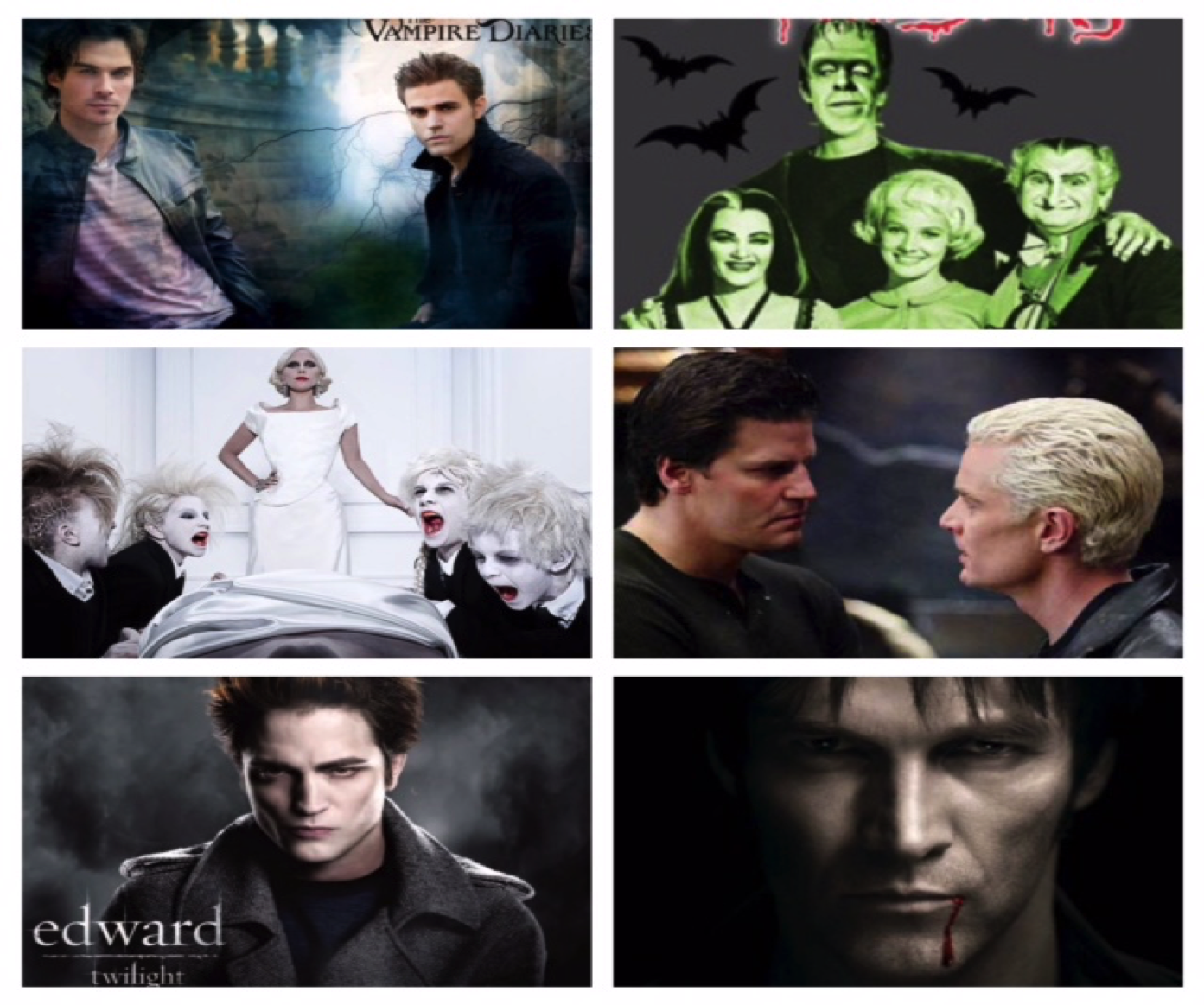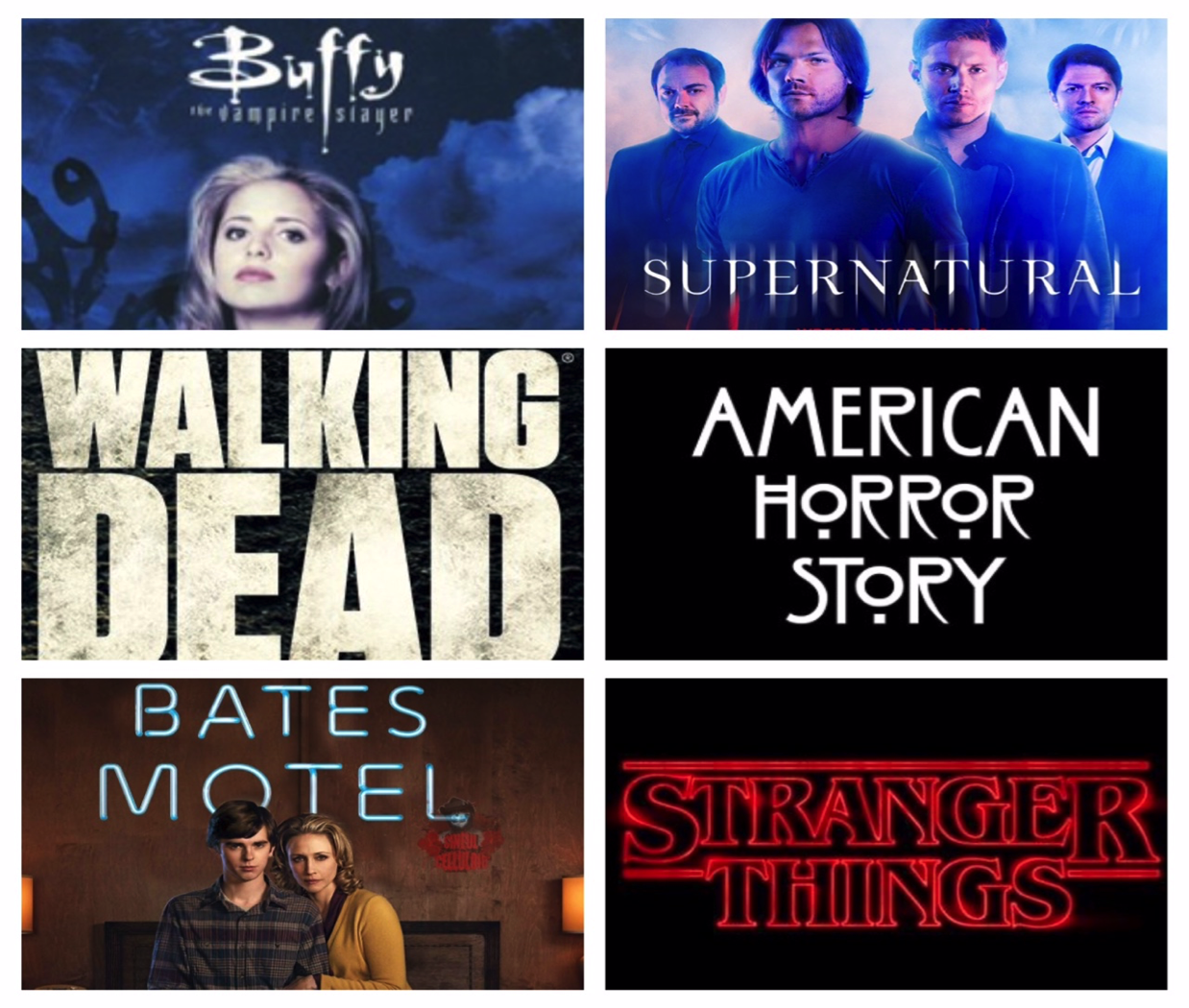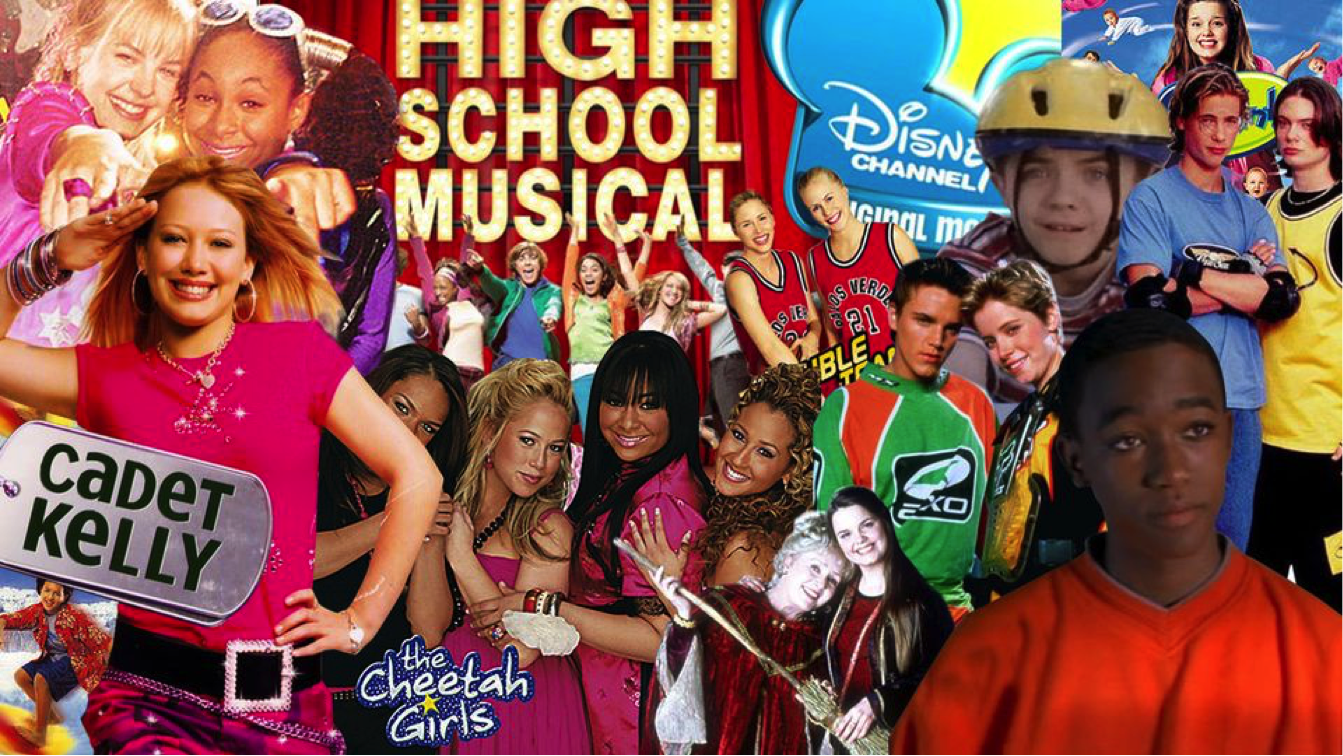America: How Greed Trumped Freedom
Much has happened over the past week as a result of Donald Trump being elected as President of the United States.
When I woke up last Tuesday morning to hear the news, I felt like the world had ended. Shock, depression, anger, fear. I felt it all at the fact that our nation, who appeared to progress so far against prejudice in the past 240 years (officially), was being torn apart. It seems as if all that hard work and determination to create and establish change was crumbling beneath us.
But this race was always more complicated than Hillary is good and Trump is bad. Throughout his candidacy, I viewed Trump as this disgusting racist, homophobic, sexist discriminatory piece of trash. I had the same negative connotations with those who supported Trump or chose to vote for him.
There are great deal of Republicans who voted for Trump because of the promise of a prosperous economy and strengthening middle class America, rather than strictly agreements on a discriminatory basis.
However, the overall outcome is a nation divided by greed. It is greed that has long dominated and continues to dictate our nation and the people that voted for economic change rather than social change and liberty and justice for all.
And while I still have strong negative feelings toward Trump, I dislike both Presidential candidates during the election race.
We, the people, were given two steaming piles of shit candidates and told to choose the lesser evil.
Hillary Clinton’s actions didn't remain true to her country. Lying and cheating to get what you want is the equivalent of greed.
Both parties fought hard against each other. However, both seemed to be largely after one objective: the title of President of the United States. The race between these two candidates proved to be selfish at the core when it came down to power. So why were many of us shocked that this major problem that continues to afflict our society dominated this election?
Because we believed in our own abilities to change a system that often cripples many of its inhabitants. Even middle class America, who have been victims of the economic system, chose the candidate they best sought fit to reform their situation.
However, Donald Trump’s platform for "change" based on a business man’s views feeds back into the revolving concept of greed.
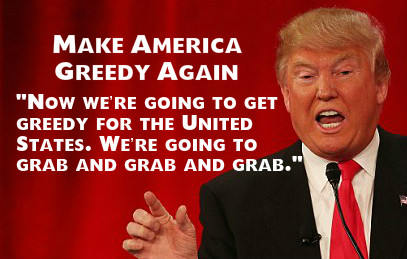
To complicate things further, some of the people who chose economic liberation are people we know, people we love. They are people who are capable of love and kindness. Yet, the promise of supporting one self or one's family financially won out; rather than realizing the big picture: freedom for all.
Hillary Clinton’s open arm stance on rights for all religions, races, nationalities, women, the LGTBQ community is essential and critical to this county’s well being.
The United States of American consists of a variety of people, not minorities, but people. They are our neighbors, our brothers, our mothers, and our best friends. They are us, and it is why we need to support one another. Because that is the only way we can properly function as a society, together.
The people that make up this nation who stand for equality and liberty are terrified to be who they are. Children are fearful, with the threat of their mothers and fathers deportation to the countries where they were born. Kids worry about going to school because of the taunting and chanting of white, male privilege in the hallways.
Making decisions by those considered to be voting adults, decisions that greatly affect children in America and taint the innocent lives of our country’s youth, it is not only majorly problematic. It is cruel and corrupts the good heartedness of children.
The majority of parents teach their children to do good and to do what is right. And yet, half the country made decisions for the good of the one rather than the good of the many.
It is an issue that has plagued our country for centuries. But in this election, greed has made a significant tear at our nation’s structure.
“The land of the free and the home of the brave."
These words sometimes used to describe the United States are now enforcing laws and the threat of repeals. It is making freedom circumstantial.
But that won’t stop us, each of us that are labeled as minorities or each of us that believe in equal rights for all, to keep fighting for the country that we are all apart of.
Influential Women in Television History
Influential women in television history such as Lucille Ball, Carol Burnett, and Ellen DeGeneres have served as idols for girls, young women, aspiring actresses and female comedians. These women have helped to shape the general population of women and their sense of strength and empowerment. Here is a list of 5 examples of strong women in tv history who played powerful roles both in front of the camera and behind the scenes:
- Lucille Ball —> Lucille Ball is often publically conceived as the ditsy house wife on the widely beloved 1950s sitcom I Love Lucy. However, Lucille Ball’s wildly popular and hilarious stage presence through physical comedic style shows Lucy’s characteristics as a smart, funny and talented actress and comedian. Yet, Lucy was not only a strong example of a successful female comedian and actress during a period where comedic television was brand new; but Lucy also accomplished roles of film-studio executive and producer. Roles such producer, director, writer, studio executive are titles that women typically didn’t have the chance to explore.
- Lucy’s initiation into television production roles began soon after she met her husband, Desi Arnaz. The pair took their “I Love Lucy” act on the road after CBS decided against taking on Lucy and Desi’s. But eventually, CBS agreed not only to put “I Love Lucy” on the air. The network allowed Lucy and Desi to create the show with their own vision; and to do so under the couples new created production company, Desilu Productions. Her start in the business and creation side of on-screen broadcasting as a television producer reflected Lucy’s intelligence and strength as a leading lady in television.
- Carol Burnett —> Actress and comedian Carol Burnett continued to pave the way for strong, funny, intelligent women in television. Burnett started her on-screen career in the mid 1950s, and continues to work into today. Among the dozens of roles she took on, one of Burnett's most memorable was on the Carol Burnett show. As Host of The Carol Burnett Show for over 10 years, Carol had total control in producing on her show. Her vision was for The Carol Burnett show to be a variety show, a show comprised up of sketch comedy. That idea was followed through. The Carol Burnett show presented some of her best comedic material and skits. Furthermore, Burnett's content influenced the world of on-screen variety shows.
- Burnett also formed a comedic duo with Lucille Ball in a few episodes of The Lucy Show and Here’s Lucy. Both Lucy and Carol worked so well together because they of their similar comedic style, and the wit and intelligence they employed in their roles as actresses.
- Recently, Carol Burnett guest starred on the Tonight Show Starring Jimmy Fallon. During the interview, Fallon flashed back to a clip of Carol on the Carol Burnett show. In the scene, there was an actual earthquake while on set. But despite the fear and alarm on set, Burnett used her quick wit to push the scene forward and make the audience laugh. She stated, “No visiting, the earth just moved. See what happens when you pay attention?” It is this kind of quick fire reactions that gave viewers the sense of how powerful actresses like Burnett were. She was more than just an actress, Carol Burnett was a visionary in creating as well as executing comedy in television.
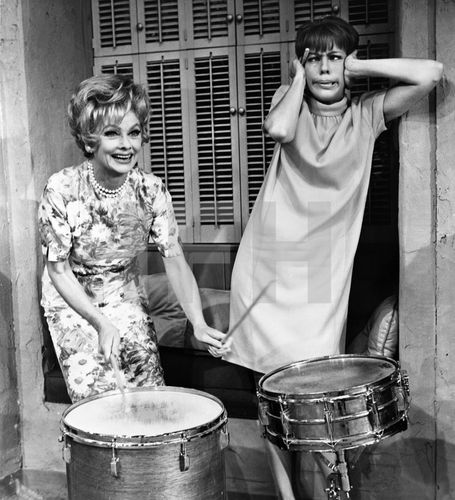
- Ellen DeGeneres —> Ellen DeGeneres professional career as an actress and comedian began in the late 1980s. DeGeneres typically stuck to the small screen in television shows that she starred in as well as episodes of other series. But her comedic wit and her love for laughter would empower Ellen to become a writer and producer, as well as a host, of her own talk show.
- Ellen’s sitcom from 1994-1998 was one of the first tv shows to feature a leading female role where the character is gay.
- The Ellen DeGeneres show originally aired in 2003 and still continues with live broadcasts today; with over 10 years later with nearly 2,000 episodes. In which Ellen DeGeneres portrays strength as an actress, comedian, content creator, producer, writer, and host. Her efforts to make television a better place for the LGTBQ community and for women will continue to shape and influence both; as well as impact both groups and their abilities to work in television, in which ever role they seek out. Just as Ellen's fellow female comedians Lucille Ball and Carol Burnett did so elegantly before her.
- Tina Fey —> In addition to her professional career as a comedian and actress for the past 15 years, Tina Fey is involved behind the screen as a producer and writer for both television and movies. Among her most noteworthy works, one includes Fey's positions of Writer and Head Writer on Saturday Night Live from 1997-2006. Fey is also credited as the creator for the series 30 Rock and The Unbreakable Kimmy Schmidt; shows that Fey also produced and contributed to as a writer. Fey’s roles in television exemplify her dedication, determination, intelligence, and natural talent to be a leading women in television both on screen as well as behind the scenes.
- Melissa McCarthy —> Melissa McCarthy has established a professional career as an actress since the late 1990s. But it was only within the past 5 years that the audience have had the opportunity to experience McCarthy’s flare as a comedian. Similar to Ball and Burnett’s style of comedy, Melissa employees a physical sense of comedy. Some of the recent movies that she's obtains major roles in include: Identity Thief, The Heat, Tammy, Spy, The Boss. Just to name a few.
- Melissa has accomplished much more than staring in these comedic films. McCarthy plays creative, behind the scenes roles of producer and writer in movies such as The Boss and Tammy. Melissa McCarthy is also working on a film project called Life of the Party, which she also wrote and produce. Additionally, she also has experience directing in a handful of episodes on a show that McCarthy stars in called Mike and Molly.
- McCarthy’s continues to accomplish roles as a successful female comedian. Yet, it doesn’t end there. Melissa continues to follow in the foot steps of great female comedians, actresses, and creators like Lucille Ball and Carol Burnett. McCarthy does this by creating content. She creates humorous story lines and scenes and knows how to capture and execute these comedic moments.
These are just a few examples of the witty, intellectual, determined female visionaries that drastically influenced and shaped t.v. history. What women in television do you idolize or inspire you? Let us know in the comment section below.
Horror Movies: How Have They Changed?
Since the early 1930s, after the release of the first talkies movie, monster movies became a major hit. Films like Dracula and Frankenstein set the president for horror films during this period.
Here’s a look back at a few of the original "monster” movies and how these supernatural creatures were portrayed during the 1930s/1940s in film:
- Dracula (1931) —> The film begins with local residents speaking about the legend of Count Dracula as a vampire, creatures that feeds on the blood of humans. Renfield, who plays a logical minded non-believer at the beginning states that it is a matter of business. Renfield says that he must go up to visit Count Dracula. The representation of vampires in Dracula is shown through the coffin in a dark, dirty basement with bugs and rodents. This image is not as glamorous as how vamps are portrayed in today’s movies and television. However, there are elements of vampire myths with strong ties to how they are viewed in television and movies today. Even the smallest amount of blood draws in a Vampire, which is still true in Vampire film and shows today. In Dracula, even the sight of a cross repels vampires. This mythical ideal has also been used in on-screen content such as Buffy the Vampire Slayer. Dracula’s appearance doesn’t appear in the mirror, which goes along with myth that vampires can’t show a reflection in mirrors.
- However, there are other elements, both mythical concepts of vampires as well as on-screen presentation and formatting, that has changed over the years. For example, the light that hits around Dracula's eyes, magnifies his eyes and leaves the rest of his face in shadows. Dracula’s lit up eyes seemingly draw in his victims, while mildly paralyzing them enough so that he can feed on them without a fight. This image of glowing eyes in vampires hasn’t changed completely, but has been altered in correlation with technological advancements. Dracula is able to enter into Lucy Westenra's room without an invitation inside, which goes against the famous myth that vampires need to be asked inside a person’s home; a concept that is often employed in vampire themed movies and television today. Renfield belongs to to his “Master,” Count Dracula. Renfield’s persona is different. It appears he has gone “crazy.” His new behavior is also shown in a newspaper story that states that was “a raving maniac; his craving to devour ants, flies, and other small living things to obtain their blood puzzles scientists. At present he is under observation in Doctor Seward’s Sanitarium near London.”
- Professor Van Helsing believes that Lucy death was the result of a vampire; but his associate Dr. Seward argues “Modern science does not admit to such a creature.” This theme of believe vs. non-believe and sane vs. insane appeared to be a very structured way of introducing the supernatural; we also see this concept in movies such as Frankenstein and Wolf Man.
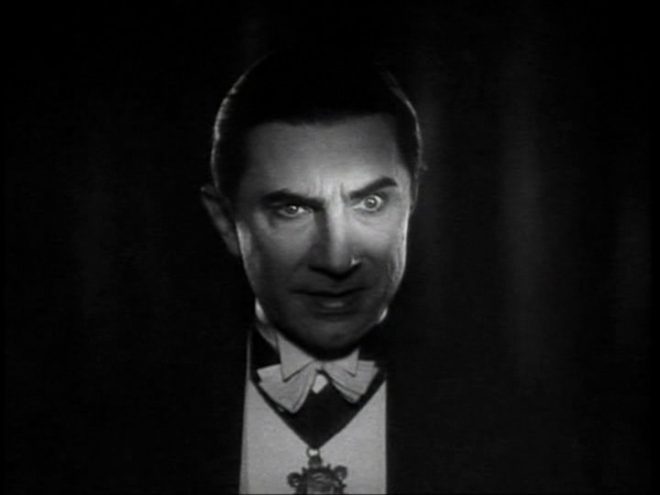
- Frankenstein (1931) —> The film begins with the famous opening presentation of Frankenstein that warns the audience what they are about to see may “horrify you, and may even shock you”; a presentation that is often reused even today when introducing a Frankenstein-themed story line. The story opens up with Henry Frankenstein, a scientists who is creating new unusual experiments and attempting to creating life through science by his “own hands.” When those closest to Henry discover his disturbing experiments, Victor calls Henry crazy at the idea that Henry thinks he could create such a monster. Henry truly believes that his experiment will work, stating, “A minute ago you said I was crazy. But tomorrow, we’ll see about that." But it is important to note that even if Henry's invention works, doesn’t make him any less crazy. Maybe he is crazy for simply conjuring up the idea to create this inhuman creature in the first place, whether it works or not.
- Once Henry’s creation comes to life, he screams, “It’s alive! Now I know what it feels like to be God.” Henry doesn’t see the flaws in his creation plan or that it could be potentially dangerous, and that no human being has the power to play God. Henry refuses that it could be dangerous when Dr. Waldman addresses this issue with Henry. Henry seems to believe that dangerous and adventurous are synonymous. “You have created a monster and it will destroy you,” said the doctor. “Patience, I believe in this monster, as you call it,” Henry responds. After Henry experiences his creation's behaviors, he starts to realize that he created a monster. Henry and Dr. Waldman then attempt to try to kill the creature.
- The audience can see these “shocking” actions from the creature of Frankenstein coming. There is a visible lead up to Frankenstein’s attacks on Dr. Waldman and Elizabeth create a sense of build up and even intensity, to some extent, for audience members. Yet the build up and intensity differs from movies and tv shows today. On-screen horror content today is created by using pop-outs and sudden actions shock audiences. Every scene is pre-meditated, from the slow creation of Frankenstein to the crowd of people with lit torches chasing down Frankenstein. It is believed that Frankenstein, the creature, is finally dead and the town rejoices. However, the film Frankenstein’s Bride reveals that Frankenstein is still alive. This method of shocking the audience by bringing about a part 2 to the story is an example of when films and television first began; a method that still exists today.
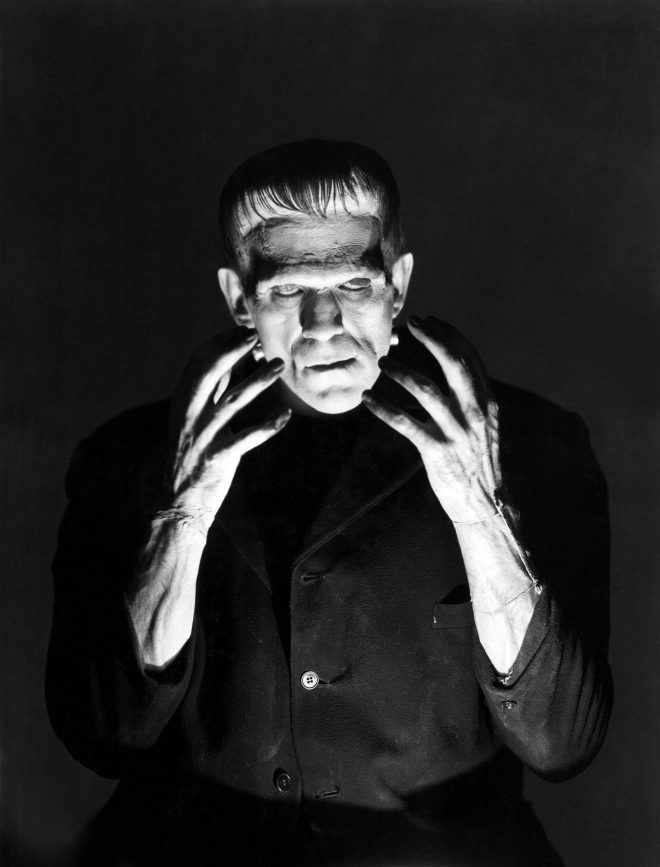
- The Wolf Man (1941) —> The film opens up by providing a definition at the beginning; a method that rarely, if ever, that still lives on in films and television today. Lycanthropy (werewolfism) - a disease of the mind in which human beings imagine they are wolf-men. Larry Talbot, who is the lead role, portrays a kind gentleman with clear moral boundaries and standards. Yet, his morality is put into question after killing the fortune teller, who was a were-wolf. Although Larry thought he simply killed a wolf, the appearance of a dead man challenged everything he thought that he knew. Were-wolf myths in the film aren’t as common as in today’s on-screen were-wolf lore. For example, “A were-wolf is a human being who at certain times of the year turns into a wolf,” says Gwen Conliffe. “Every were-wolf is market with a pentagram, it sees it in the palm of his next victims hand,” she continues.
- Although there are no surprises, with completely expected scenes, audiences during the 1940s may have had different perceptions of shocking and unexpected occurrences in films. Maybe it is the telling of the lead character’s story, rather than unexpected plot twists, that entertained audiences during the 1930s and 1940s.
- Larry’s first kill as a were-wolf shows hesitation, briefly addressing his inner humanity and the morality of his human side. Yet, the animalistic primal urges lead Larry to ultimately kill. Larry is hated by the towns people as an animalistic murder for killing the psychic who he seemingly thought was a wolf. The doctor views Larry as sick when Larry asks the doctor if were-wolves exist; because he is mentally sick, the Dr. states that he should leave town as a result of his “sickness”; Sir John Talbot ties up his son, Larry. Sir John tells the doctor that Larry will realize this is all in his head after the hunt is over. However, the gypsie women’s words force Sir John to confront his thoughts/suspicions all along that maybe Larry really is a were-wolf. When the were-wolf Larry attacks Sir John, Sir John has no choice but to kill the animal, his son.
- As in movies such as Dracula and Frankenstein, Wolf Man presents a similar theme of these supernatural creatures in which you need to see to believe. However, seeing these creatures also brings these characters to question their own sanity.
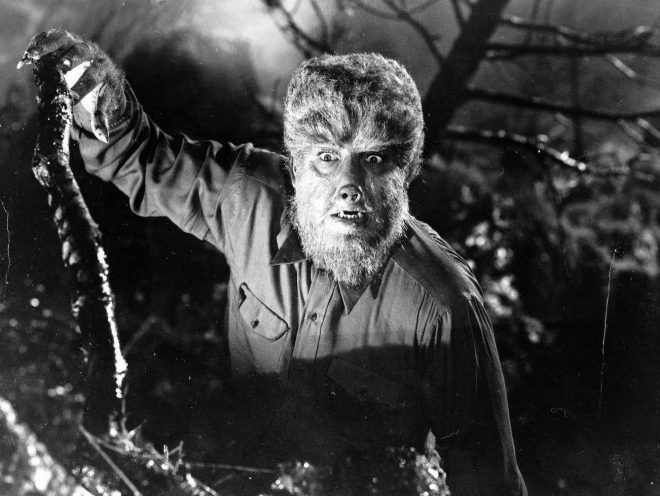
- The Wizard of Oz (1939) —> This film differs from the typical image of scary movies involving a supernatural creature/s during the 1930s/1940s period; Yet, the Wizard of Oz was the first popular portrayal of witches in movies. The film doesn’t confine the image of witches as simply evil or wicked. The Wizard of Oz shows the good and beautiful witch, Glinda, who helps Dorothy; versus the Wicked Witch of the West, who sets out for destruction and the powerful Ruby slippers that Dorothy; possesses. This interesting plot line that brings an array of unique, un-human creatures into one story line. Most of the un-human creatures, such as the lion, the scarecrow and the tin man are all morally good; they all have good intentions, despite their self perceived flaws of lacking a heart, a brain, or courage. Movies and tv shows on the subject of witches didn’t become popular until the after the 1960s. The topic on witches expanded largely in the mid 1980s and into the 1990s with films like The Witches of Eastwick, Hocus Pocus, Practical Magic, The Blair Witch Project, etc.
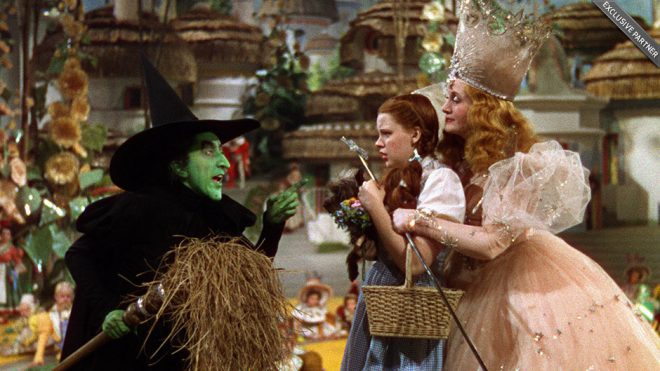
In nearly 100 years, the portrayal of on-screen monster films and television has changed a lot. Movies and television have evolved a lot over a century. But one of its most prevalent examples is in the supernatural/horror genre. Today, horror movies have more intense scenes, more complex and heavily involved story lines, and technology that has majorly enhanced the appearance of these mythical supernatural creatures. Even the depiction of these monsters and their character arcs have become more involved over time. New or old, it is interesting to see the evolution of these legendary on-screen creatures. And of course the original on-screen depiction of the monsters that started it all.
On-Screen Vampire Characters: Best to Worst
With Halloween less than a week away, vampires play a major role during this haunting season. Over the past 8 years, the concept of vampires has blow up uncontrollably all over the on-screen platform in television and movies. But which vampire characters were/are the best and worst?
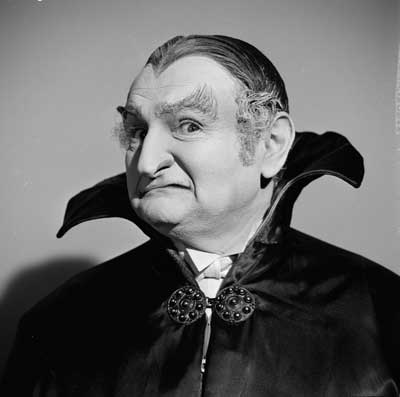
Here is a scale of our top 5 vampire tv series, from best to worst:
- Angel and Spike, Buffy the Vampire Slayer --> Although Buffy’s number one mission as the Slayer is to kill vampires, Buffy usually finds herself attracted to vampires. This presents an interested moral dilemma for Buffy; she involves herself personally with her work while attempting to compartmentalize her job of slaying vampires from the vamps that she falls for. The character Angel presents the unique quality, obtaining a soul; which is unusual for vampires in this show. Yet, the fact that his soul is a curse that could be broken, leaving him soul-less, exhibits an uneasy balance; this see-saw effect could sway at any moment and change Angel, as well as his relationship with Buffy. Spike, on the other hand, calls for a different situation. While Spike’s refrain from killing people is controlled, his involuntary actions start to effect his emotions in relation to others; namely those relationships closely surrounded by Buffy. Buffy the Vampire Slayer is a prime example of how well depicted these characters are; from the protagonist at the very beginning to the to the arch nemesis who gradually becomes a main character with a finely detailed character arc.
- Lily and her Father (known as Grandpa), The Munsters --> Back in the 1960s, fantasy-type series were on the rise in television. Shows like Bewitched and The Munsters presented a desire for these characters to fit in, and to be “normal.” In The Munsters, Lily and her father are vampires. Their attempts to be “good” and to fit into society with other human beings shows their yearning for assimilation. This concept of trying to be “normal” strengthens with every generation: from grandpa, to Lily, to Lily’s werewolf son Eddie. This program's idea of humanization and wanting to be accepted in society is a interesting, unique take from a monster's perspective. The desire for members of the Munster family to have some humanness to them also ventures out of the glorified view of vampires; a view that is overly used in television today.
- The Salvator Brothers, The Vampire Diaries--> This story presents a unique character contrast between vampire brothers Stefan and Damon Salvator. Stefan, the bad gone good vampire forces himself to move according to his moral compass; while Damon straddles the line between good and bad. However, this show follows the same repetitive vampire story formats of attempting to be good and meeting the “love of his life,” along the way. It is this general concept that makes the show simply average in its overall beginning plot. However, it is the actions, unlikely bonds, deaths, and plot twists over the course of the story line that make it above average during the series life span.
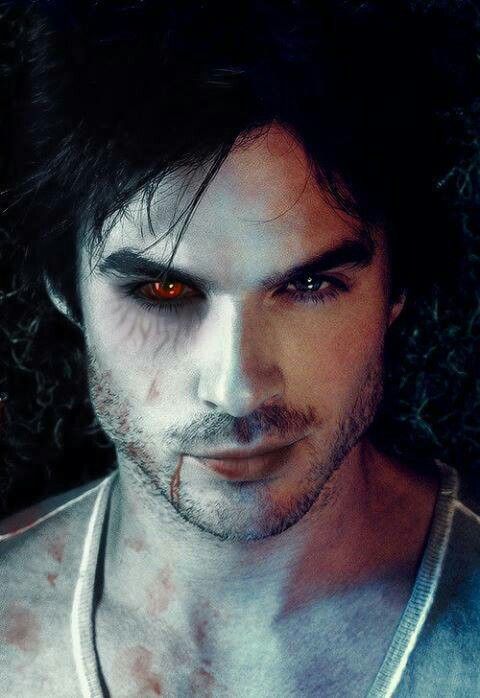
- The Countess, American Horror Story Season 5 --> The concept of American Horror Story’s season 5 alters from the typical vampire man who tries to be good and meets the love of his life. In AHS Hotel, a powerful vampire countess essentially runs a haunted hotel. The Countess’s needs come as first priority and highlight her strength over others. However, her overall mission or goal appears hindered by these primal needs, weakening the overall strength of the character. The character needs to set a goal and aim towards achieving that goal throughout the coarse of the story. This half-attempt is why the portrayal of vampires in the show, namely the Countess, is mediocre at best. It is the Countess’s ex-lover, the vampire Donovan, creates a clear mission throughout the series and persistently tries to fulfill that goal. That is what strengthens the series and further enhances it by creating a unique, unexpected plot twist.
- Bill Compton, True Blood: Bill portrays this overly done concept of vampires in television during the 21st century, and their. Usually, the series or movie open up when they meet an “interesting girl” who becomes the love of their life. However, this theme is over done time and time again over the past 10 years. Bill Compton lacks and in depth character arc. It seems that his only goals are to refrain from killing humans and to protect his newfound love; in this case, Bill wants to protect Sookie. But an "unexpected" change of events causes this “protagonist” vamp to give into his nature of being a vampire.
- Edward Cullen, Twilight: Although the awful portrayal of Edward Cullen are in four of the Twilight Saga films rather than a tv series, this movie collection is definitely worth mentioning as one of the worst vampire on-screen stories. As explain previously, Twilight follows the repetitive pattern of vampire stories that focus on a “protagonist” vampire and his desire to be good while meeting the love of his life at the shown or movie’s start. But what drives this movie over the edge in comparison to other vampires stories with similar plot lines is the terrible acting of the two lead roles. There is a dependence on flashbacks to create the characters and their stories. This film franchise completely lacked character arcs and developments, showing limited quirks, real time experiences, actions and dialogue to establish these character. Additionally, the over-dramatized events, make these scenes seem as if the world was ending; instead of using them as opportunities to highlight climactic scenes. Yet, even with the highly dramatic occurrences, there was almost always one tone/expression that almost every character portrayed: solemnity.
What do you think of our list? Do you agree with our ratings of on-screen vampires? Let us know in the comment section below.
Top Thriller Television Shows to Watch this Halloween
As Halloween growing closer in the next two weeks, there are endless television shows in the horror/thriller, and/or supernatural genres to choose from. Here is a list of some of the most noteworthy television series to consider watching during this haunting season:
- Buffy the Vampire Slayer —> Buffy the Vampire Slayer centers around a 16 year old girl, Buffy Summers. The series shows Buffy’s journey of fulfilling her destiny of slaying vampires, among other creatures; one day at a time, this powerful and witty girl continues to fight and save the world, while trying to survive both life as well as high school. The character of Buffy Summers stands out as a strong female leading figure during the late 1990s. Buffy the Vampire Slayer is an example of a supernatural show during a period when the supernatural genre in television was limited and less explored. It’s a great classic show to consider watching this Halloween.
- Supernatural —> This story centers on two brothers, Sam and Dean Winchester, who were raised into the business of monster hunting by their father, John Winchester. The pilot episode opens with Sam and Dean as young children, when their mother was killed by a monster. After Mary Winchester's death, John decided to take Sam and Dean on the road, hunting down the demon that killed his wife; along the way, John kills monsters while teaching Sam and Dean the trade. The series began in 2005 and continued to pave the way for the supernatural television show genre. Similar to Buffy, Supernatural covers a wide range of supernatural creatures in every episode; as well as overall themes in the fight of good vs. evil in every season. Supernatural is the longest running show of this genre; with 11 seasons available on Netflix, this series is sure to keep you preoccupied throughout October.
- The Walking Dead —> Although I have never experienced more than a few episodes of this series, this well established show dives into the zombie apocalyptic world; it has been a fan favorite since its start in 2010. As is the case with many apocalyptic themes in television shows, the main purpose is survival; we, the audience, get to watch the action unfold through character developments and relationships among these characters that help or hinder their primary need to survive. With an IMDB rating of 8.6, this show appears to be a must watch. You can enjoy binge watching the 6 seasons available of The Walking Dead on Netflix.
- American Horror Story —> American Horror Story is an anthology series that makes every season into an individual story. AHS takes the idea to create a horror movie in television format and to tell that story over the course of 12 to 13 episodes. So far, the show consists of 6 seasons: Murder House, Asylum, Coven, Freak Show, Hotel, and Roanoke. If you’re a fan, you may not like every season and it’s theme; however, it is interesting that every season centers on a new story. If you’re new to American Horror Story and all 6 stories, you may want to check it out this Halloween.
- Bates Motel —> Not all of our top picks need to have supernatural elements. Bates Motel comes from Robert Bloch’s 1960s book "Psycho." But with a twist. In Psycho, the leading character is portrayed by 40 year old Norman Bates, who runs Bates Motel with his mother. The novel depicts Norman’s psychological thoughts and feelings and how his impulses to kill become reality, rooted in action. The series Bates Motel serves as a sort of prequel to Psycho; Bates Motel centers on Norman Bates, a high school student who’s mother, Norma Bates, recently bought a Motel. Bates Motel shows the developing relationship Norman has with his mother, Norman's psyche, and how his mind drives him to become a killer in the town of White Pine Bay. This psychological thriller series will always keep you on your toes and have you wondering what Norman is thinking.
- Stranger Things —> Recently, Netflix launched its a new thriller Stranger Things. This series provides a genuine 80s feel with enhanced cgi features where it is appropriate. The show focuses on a group of friends in middle school, when one of the friends mysteriously disappears. Throughout the course of this 8 episode series, the audience discovers more about the boy vanishing and the complicated factors that play roles in his disappearance. The younger kids in this show, namely played by characters friends Dustin, Mike, Lucas, and Will, present a pure sense of trust, friendship, and promise between kids; it shows how children are not tainted by the secrets of the adult world; for instance, the innocent state of mind these boys have, believing that hitting a supernatural creature with rocks and a slingshot and expecting it to work.
- Furthermore, Stranger Things also shows the interesting different family dynamics of the Wheeler family, who seemingly has the “perfect” nuclear family; vs. the Byers family, with a single mom working long, hard hours at the nearby mini mart. Yet, the Byer’s family members have a closer connection and stronger sense of communication with one another. There are many factors that make this powerful new series to watch. Overall, this series shows a collection of scenes filled with complete suspense, moments of laugh out loud comedic material, unexpected alliances, and friendship. This show will leave you wanting to watch more, despite the perfectly wrapped up season finale.
Do you agree with our list? Let us know in the comments section below.
Do the clothes we choose reflect ourselves as a person?
What does what we wear say about us?
Do the clothes we choose reflect ourselves as a person? It seems that the clothes that we choose tend to make a statement to us and our personal sense of what we like, how it fits us individually, and of course the revolving door of trends that go in and out every decade; as well as the impression we want to make on the outside world. Clothing can also represent a sense of legality, authority, and prestige in certain uniform design choices.
Is our sense of style tied to something stronger than our cognitive decision to choose clothing patterns? According to an article published by the New York Times, that we think with our bodies as well as our brains.
In a series of studies conducted by Dr. Adam D. Galinsky, a professor at Northwestern University, he tested how clothing impacted individuals on their cognitive and psychological processes. In an experiment with 58 undergraduates, students were randomly assigned a white lab coat or normal street clothes; the students were then asked to spot the inconsistencies in a selective attention test. The results: those who wore the lab coat made significantly less errors than those wearing street clothes.
“I love the idea of trying to figure out why when we put on certain clothes, we might more readily take on a role and how that might affect our basic abilities,” said Joshua I. Davis, an assistant professor of psychology at Barnard College.
Or is it more simple than that? Is the clothing that we choose merely a result of personal taste and what we like. For many of us, comfortability is key. If I could, I would live in sweatshirts, leggings, and converse or boots. However, this isn’t always socially acceptable.
Society has taught us what does and does not look appropriate in certain situations; for example, weddings, funerals, the work place; but even some places of work are starting to accept jeans as a viable clothing option at certain places of employment
This begs the question: what else is society telling us about what to wear?
Confidence also plays a key role in what we choose to wear. It influences how we carry ourselves and how we interact with others. Sizes small through large and “regular" sized pants is a major limitation in our society.
Sizing in certain clothing stores like Abercrombie and Fitch, who just recently starting carry above a size 10 in women’s clothing, have started carrying larger sizing for the main purpose of selling product.
There are many components that factor into how we choose to dress ourselves everyday. Personal taste, self confidence, and how we believe others view us all play roles in the decision making process. Yet, it is important to note that “others” exceeds outside of the people you pass by in everyday life. Society largely impacts how we view ourselves in respect to clothing.
Top 5 Scariest Places to Visit This Halloween
Now that it is the month of October and with Halloween approaching, haunted houses filled with fake zombies and dropping skeletons are opening to the public. But what about the all year-round locations that have claims of hauntings? Considering the local clown outbreaks in Chicago, the normal, everyday parks may seem the most terrifying to some people. But here are a few examples of some of the most noteworthy real-life horror locations in Illinois.
1 Bachelor’s Grove Cemetery in Midlothian, IL —> Among the Rubio Woods lies one of the most haunted cemeteries in Illinois; maybe even one of the most haunted cemeteries in the United States as argued by history lovers and ghost fanatics. Bachelor’s Grove Cemetery first burial was Eliza Scott in November of 1844, before the Civil War. Newspaper reports have also stated earlier burials held at Bachelor's Grove. In 1935, the Blue Island Sun Standard published that William B. Nobles was buried in Bachelor's Grove Cemetery in 1835. However, Bachelor’s Grove wasn’t legally considered a graveyard until records of the cemetery came to light, after the property was taken over by Frederick Schmidt in 1864.
Since the 1960s, Bachelor’s Grove Cemetery has been closed to car traffic; making it even more terrifying that the only way to roam around this graveyard is by foot. Locals over many generations report sitings of phantom cars, ghosts, glowing floating orbs; and more notably, legends of a ghost known as Madonna of Bachelor’s Grove, the Caretaker who supposedly lived on the grounds killed his family; the Hook Man, the farmer and the horse who supposedly drowned in the Bachelor’s Grove pond, the phantom dog, etc. There has also been factual evidence present of satanic rituals and grave openings/robbings at Batchelor’s Grove since the 1960s.
2 Peoria State Hospital in Bartonville, IL —> Peoria State Hospital, formerly known as the Illinois Asylum for the Incurable Insane, was active between 1902 to 1973. Because the hospital shut down in the early 70s, there isn’t too much factual information accessible online about the history of the establishment. Many reports, including the leading Doctor Dr. George A. Zeller of Peoria State Hospital, speaks of strange occurrences inside the hospital during its time of operation. One of the incidents being in 1910, when a patient by the name of Manual Bookbinder passed away. At Bookbinder’s funeral, numerous witnesses in the crowd, including Dr. Zeller, reported seeing Bookbinder’s ghost standing near a tree. According to Dr. Zeller, the funeral procession had to open the casket to verify that Manual Bookbinder, or Old Book as they called him, was in fact still inside his coffin.
3 Benedictine University in Lisle, IL —> Benedictine University, formerly known as St. Procopius College, was established by the Benedictine monks in 1887. The University’s nearby wooded area, along with Lake Saint Benedict and the college’s local cemetery emphasize the creepy feel of the campus. Ursula Bielski is a former Benedictine University student, historian, author, and founder of Chicago Hauntings Inc.; Bielski has strong credibility as the leading figure in the Chicagoland’s folk lore. According to Bielski, numerous students even tried to contact a ghost/spirit through the use of a ouija board. Reports of rumored exorcisms, alleged deaths on campus, and other supposedly strange occurrences have led some to believe that ghosts roam the campus of Benedictine University.
4 Joliet Correctional Center in Joliet, IL —> For nearly 150 years, Joliet Correction Center was home for small-scale criminals to noteworthy killers; including the infamous serial killer John Wayne Gacy. Gacy was sent to Joliet Correctional Center before being transferred to Stateville Correctional Center. The prison first originated in 1858 as a replacement for Alton, Illinois’ first ever state prison. Over time, Joliet Correctional Center became one of the nation’s largest prisons. The prison closed from needed cut backs in the corrections budget. But is the abandoned prison really haunted by supposed stories of ghosts; or is it the fact that it is an abandoned prison that people create these folklores?
5 Iroquois Theater and Death Alley in Chicago, IL —> On December 30th, 1903, the Iroquois Theater burned to the ground after a lighting issue turned out of control. During the night of the fire, about 2,000 people sat inside to watch the musical “Mr. Blue Beard.” That December night, over 600 people died as the fire continued to blaze. The new building that stands in the Iroquois Theater’s place is the Oriental Theater. Some people have claimed to hear screaming and other strange noises inside the theater; others have told stories that exist in the alley behind the theater, which is known as Death Alley. Some have said to have seen the ghosts of those who died in the Iroquois Theater fire over 100 years ago, lingering in the alley.
Do you agree with our list? Are strange, supernatural elements lurking in these supposedly haunted hotspots, or are these just stories of legend and folklore? Many of us might just have to visit these places to decide for ourselves what horror lies behind these stories.
Disney Channel Original Movies: Have They Changed?
Being a kid in the 90s and watching disney channel at least 50% of the time, I also grew up loving disney channel original movies. So obviously, I started to binge watch as many dcoms as I could when I noticed they were on demand. Here’s a list of the top 6 Disney Channel Original Movies worth mentioning:
- Zenon (1999) (6.4 rating) —> A young girl takes on the task of saving her home and community in outer space with the help of her friends and family.
- The Color of Friendship (2000) (7.4 rating) —> This dcom discusses the impacts of environment, race and culture on relationships and how a child's sense of morality and friendship is not confined by where you come from or the color of your skin.
- Motocrossed (2001) (6.8 rating) —> This movie focuses on female strength and that a girl/woman can succeeding in anything they put their minds to, especially with the strength and support of friends and family.
- Tru Confessions (2002) (7.8 rating) —> This dcom highlights something much more important than a child with disabilities. Tru Confessions shows what the support of family really means and that disabilities don’t define you. To Tru and her parents, her brother Eddie is a brother, a son, and a friend first and foremost.
- Jumping Ship (2001) (6.3 rating) —> This movie shows how three individuals, despite their differences, can work together to survive and create strong friendships with one another. Although this movie contains a lower rating, this was my favorite dcom growing up as a kid.
- Double Teamed (2002) (6.2 rating)—> This movie shows the value of teamwork and sisterhood, and sportsmanship. It also highlights that everyone is an individual and everyone is different, even twins.
Imagine, for those who grew up with these movies, watching disney channel original movies for the first time as adults. Our admiration and loyalty for some of these disney films probably wouldn’t be as strong.
As a kid, these movies were pure entertainment. But the life lessons buried within these movies also helped to inform us. It provided us kids with strong examples of morality in family and friendship.
This brings into question whether disney channel original movies were better 20 years ago compared to today, which seem cheap or cheesy to me now. Somehow, dcoms today seem to pale in comparison; that they are not the same level of quality as dcoms of the late 90s/early 2000s. However, could this just be because as adults, we view these kids movies differently now; rather than our innocent, undeveloped child brain would.
According to IMDB the majority of dcoms, both new and old, contain ratings ranging between a 5.5 and a 7.5; this would be deemed on the lower side of average. But again, this system of rating by adults goes back to the same concept. Watching these movies as adults takes on a completely different perspective of Disney Channel Original Movies compared to the child adoration of these movies. Watching dcoms at a young age impacts both the kid watching these films; as well as a nostalgic adult remembering the young fondness for Disney Channel Original Movies.

